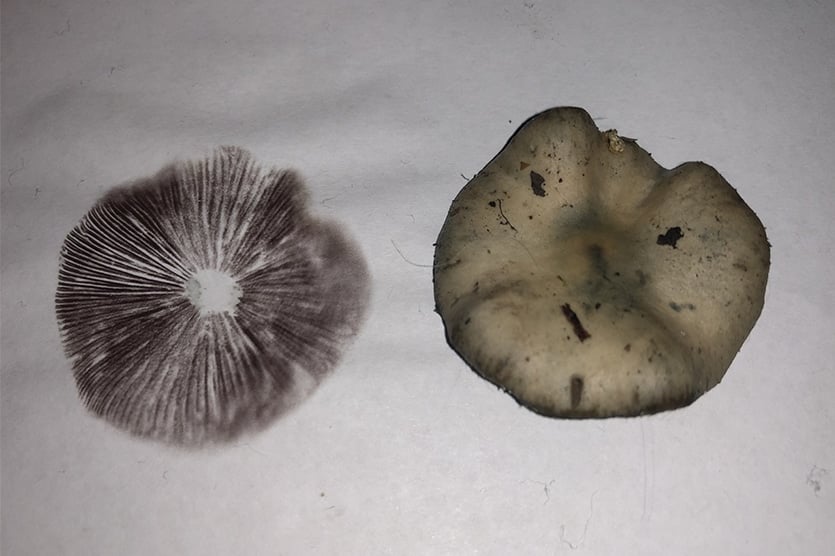

This outer layer of the spore often is not complete, but has a clear patch in many species just above the attachment, this clear patch is called a plage. The spores of Galerina feature an ornamentation that comes from the outer layer of the spore breaking up on maturity to produce either warts, wrinkles or "ears", flaps of material loosened from where the spore was attached to the basidia. Ecologically, all Galerina are saprobic, growing in habitats like rotting wood or in moss. However, there are many exceptions, and many species of Galerina lack one or more of these microscopic characteristics. Many species also have characteristic tibiiform cystidia. Microscopically, they are highly variable as well, though most species have spores that are ornamented, lack a germ pore, and have a plage. The pileus is typically glabrous and often hygrophanous, and a cortina-type veil is present in young specimens of roughly half of recognized species, though it sometimes disappears as the mushroom ages in many of these species. Galerina fruiting bodies are typically small, undistinguished mushrooms with a typical " little brown mushroom" morphology and a yellow-brown, light brown to cinnamon-brown spore print. Galerina patagonica at Marriott Falls Track, Tasmania, Australia Species have a pileipellis that is a cutis, and ornamented spores that are brown in deposit, where the spore ornamentation comes from an extra spore covering. The genus Galerina is defined as small mushrooms of mycenoid stature, that is, roughly similar in form to Mycena species: a small conical to bell-shaped cap, and gills attached to a long and slender cartilaginous stem. They are often found growing on wood, and when on the ground have a preference for mossy habitats. Species are typically small and hygrophanous, with a slender and brittle stem. The genus is most noted for some extremely poisonous species which are occasionally confused with hallucinogenic species of Psilocybe. Retrieved from the MushroomExpert.Galerina is a genus of small brown-spore saprobic fungi (colloquially often mushrooms), with over 300 species found throughout the world from the far north to remote Macquarie Island in the Southern Ocean. This site contains no information about the edibility or toxicity of mushrooms. Annals of the Missouri Botanical Garden 3: 195–200. New or interesting species of gill fungi from Missouri. My translation of the key in this text is available here. Le genre Panaeolus: Essai taxinomique et physiologique. Panaeolus alcidis, a new species from Scandinavia and Canada. A new species of Panaeolus from South America. Taxonomische Revision der Gattungen Panaeolus und Panaeolina (Fungi, Agaricales, Coprinaceae). Fungi of Switzerland: A contribution to the knowledge of the fungal flora of Switzerland. Ola'h's text is entirely in French I have translated the key into English, but not the species descriptions.īrietenbach, J. Gerhardt's treatment includes an English version of the keys, but the species descriptions are not translated from German. The two major monographs of the genus (Ola'h, 1969 Gerhardt, 1996) are unfortunately not in English, and are hard to obtain. But I can tell you that it's probably easier-and safer-to simply try keying your mushroom out as a Panaeolus (about 30 described species worldwide) and, if things don't work out, then take the Psathyrella Challenge (Alexander Smith's 1972 monograph describes 414 species for North America, most of which were collected once, by Smith).īeyond a few "easy" species, identification in Panaeolus requires microscopic examination, a good interlibrary loan desk, and the ability to read French and German. If you think it might be worth your time to keep a dangerous chemical around so that you can get it near your eyes in order to watch for fading spores through your microscope, I can't stop you. Spores fading when mounted in concentrated sulfuric acid.For these cases, mycologists have kindly developed the following: These features, taken together, will eliminate most contenders-but confusion with species in the genus Psathyrella is probably inevitable, even after applying the above rubric. Gills that become mottled with shades of gray and black as the spores mature.Grayish, brown, or blackish caps that are usually conic or bell shaped.A dark brown to purple-brown or black spore print.The mushrooms are saprobes that decompose grass litter, dung, or forest litter, and the physical features that define the genus include: Species of Panaeolus are not likely to excite most mushroom collectors, since they are almost without exception LBM's ("Little Brown Mushrooms"), and most require microscopic examination for accurate identification. The Genus Panaeolus (MushroomExpert.Com) Major Groups > Gilled Mushrooms > Dark-Spored > Panaeolus


 0 kommentar(er)
0 kommentar(er)
